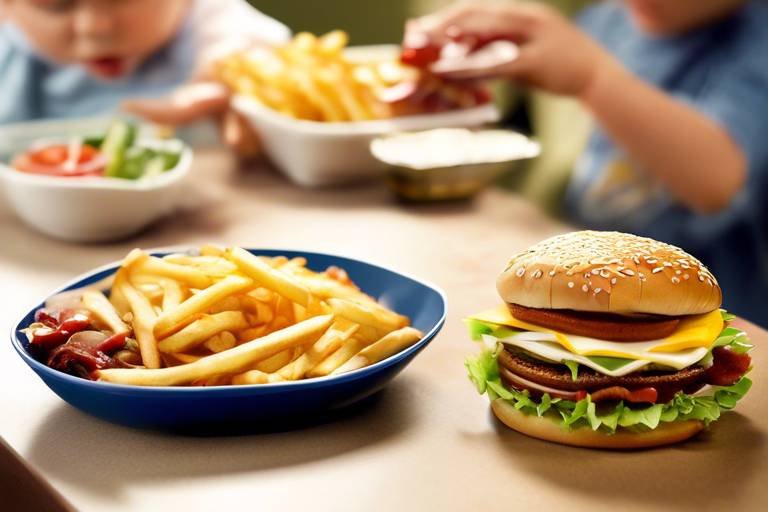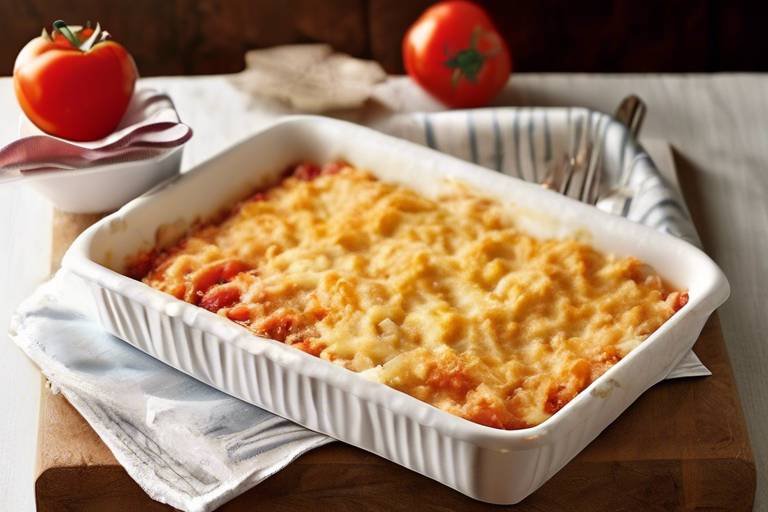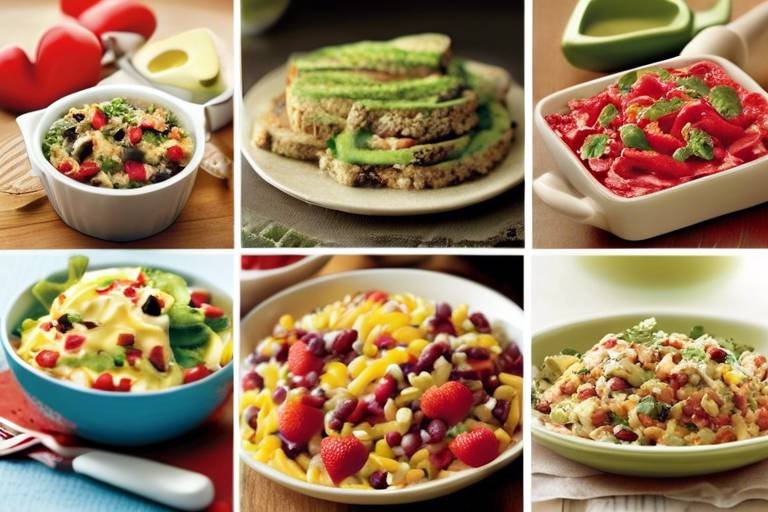The Benefits of Home Cooking for Family Nutrition
In today's fast-paced world, the art of home cooking often takes a backseat to convenience and speed. However, taking the time to prepare meals at home can be a game changer for family nutrition. Imagine the warmth of a kitchen filled with the aroma of freshly cooked meals, where family members gather not just to eat, but to connect. Home cooking is not merely about feeding the body; it's about nurturing the soul and building lasting memories. This article explores how preparing meals at home can enhance family nutrition, foster healthier eating habits, and strengthen family bonds through shared cooking experiences and nutritious meal planning.
One of the most significant advantages of home cooking is the ability to control the ingredients. When you cook at home, you can choose fresher, whole foods that are packed with nutrients, steering clear of the preservatives and unhealthy fats often found in takeout or processed meals. This control translates to improved nutritional quality for your family. For instance, you can substitute white rice with quinoa or incorporate more vegetables into your dishes, making meals not only healthier but also more colorful and appealing. The result? A family that enjoys delicious, nutritious meals together, setting the stage for better health.
Let's talk about the wallet. Cooking at home is not only healthier but also cost-effective. By planning meals ahead of time, families can save money and reduce food waste. Consider this: when you buy ingredients in bulk and plan meals around sales, you can significantly cut down on grocery bills. A simple spreadsheet or even a notepad can help you track your meal plans and grocery lists. For example:
| Item | Store A Price | Store B Price |
|---|---|---|
| Chicken Breast (1 lb) | $3.99 | $4.49 |
| Brown Rice (2 lb) | $2.50 | $3.00 |
| Broccoli (1 lb) | $1.50 | $1.75 |
By comparing prices, you can make informed decisions that benefit both your health and your bank account.
Now, let’s dive into the concept of batch cooking. This technique allows families to prepare multiple meals at once, saving precious time during busy weekdays. Imagine coming home after a long day and having a nutritious meal ready to go! Batch cooking not only ensures that nutritious options are readily available but also reduces the temptation to order takeout. You can cook large portions of soups, stews, or casseroles and store them in the fridge or freezer for later use. This approach is especially beneficial for families with hectic schedules, as it helps maintain a healthy diet without the daily stress of cooking.
To maximize efficiency in your kitchen, consider employing some time-saving techniques. Preparing ingredients in advance, using a slow cooker, or investing in quality storage containers can make a world of difference. For example, chopping vegetables and marinating proteins on the weekend can cut down on prep time during the week. Additionally, organizing your pantry and fridge can help you quickly find what you need, making the cooking process smoother and more enjoyable.
Freezing meals is another practical way to preserve home-cooked dishes. When done correctly, freezing can maintain the taste and nutrition of your meals. It’s essential to use airtight containers or freezer bags to prevent freezer burn. Labeling your meals with dates and contents can help you keep track of what you have on hand, ensuring that you always have a healthy option ready to go.
Involving family members in the cooking process fosters teamwork and teaches valuable skills. Cooking together can be a fun and educational experience, where everyone learns about different ingredients and cooking techniques. Whether it’s chopping vegetables, stirring sauces, or setting the table, every task contributes to a sense of accomplishment. This shared experience not only improves relationships but also encourages healthier eating habits, as family members are more likely to enjoy meals they helped create.
Home cooking promotes healthier eating habits by reducing reliance on processed foods. When families commit to regular home-cooked meals, they cultivate a culture of healthy eating. This shift can be as simple as replacing a few takeout nights with cooking at home. The benefits are profound: less sodium, fewer unhealthy fats, and a greater variety of nutrients. Plus, when you cook at home, you can experiment with different cuisines and flavors, making healthy eating exciting!
Creating balanced meals is essential for family nutrition. A well-rounded plate should include a variety of food groups: proteins, grains, fruits, and vegetables. For example, a colorful stir-fry with chicken, brown rice, and a mix of seasonal vegetables not only looks appealing but also provides a range of nutrients. Teaching family members about portion sizes and the importance of each food group can empower them to make healthier choices.
Home cooking allows for easy adaptation of recipes to meet specific dietary needs. Whether someone is gluten-free, vegan, or has food allergies, cooking at home enables families to modify meals accordingly. This flexibility ensures that everyone can enjoy delicious food without compromising their health. For instance, substituting almond flour for regular flour can make a recipe gluten-free, while using plant-based proteins can cater to vegan diets.
Cooking together can strengthen family bonds and create lasting memories. The kitchen becomes a hub of laughter, conversation, and creativity. Sharing stories while chopping vegetables or discussing the day’s events while stirring a pot fosters communication and connection among family members. These moments are invaluable, creating a sense of unity and belonging that extends beyond the dinner table.
- What are some easy recipes for beginner cooks? Start with simple dishes like pasta, stir-fries, or omelets that require minimal ingredients and steps.
- How can I get my kids involved in cooking? Assign them age-appropriate tasks, such as washing vegetables or mixing ingredients, to make cooking a fun family activity.
- What are some budget-friendly meal ideas? Consider meals like chili, vegetable soup, or casseroles that can be made in large batches and are cost-effective.

Improved Nutritional Quality
When it comes to family nutrition, the impact of home cooking cannot be overstated. One of the most significant advantages of preparing meals at home is the ability to control the nutritional quality of the ingredients used. Unlike pre-packaged or restaurant meals, which often contain hidden sugars, unhealthy fats, and excessive sodium, home-cooked meals can be tailored to meet the specific health needs of your family. By choosing fresh, whole ingredients, you can ensure that your meals are not only delicious but also packed with essential nutrients.
Imagine walking through a local farmer's market, selecting vibrant vegetables and ripe fruits. The colors alone can entice you to make healthier choices. Home cooking allows you to incorporate these fresh ingredients into your meals, leading to improved overall nutrition. For instance, you can easily add a variety of vegetables to your stir-fries or opt for whole grains instead of refined options. This flexibility means you can create meals that are not just tasty but also nutrient-dense.
Moreover, cooking at home encourages the use of healthier cooking methods. Instead of frying, you can grill, steam, or bake your meals, which significantly reduces the amount of unhealthy fats consumed. This shift in cooking techniques can lead to lower calorie intake and better health outcomes for your family. In fact, studies have shown that families who cook at home regularly tend to consume fewer calories and have a lower risk of obesity and related health issues.
Another aspect to consider is the ability to customize meals to fit your family's dietary preferences and restrictions. For example, if someone in your family is lactose intolerant or has a gluten allergy, cooking at home allows you to modify recipes easily. You can substitute ingredients or explore alternative recipes without sacrificing flavor or nutrition. This adaptability not only caters to individual needs but also promotes a culture of health and wellness within the family.
To further illustrate the nutritional benefits of home cooking, consider the following table comparing the nutritional content of a typical home-cooked meal versus a restaurant meal:
| Meal Type | Calories | Sodium (mg) | Fat (g) | Fiber (g) |
|---|---|---|---|---|
| Home-Cooked Meal | 400 | 300 | 10 | 8 |
| Restaurant Meal | 800 | 1200 | 30 | 3 |
This table highlights the stark differences in nutritional quality. As you can see, home-cooked meals tend to be lower in calories and sodium while providing more fiber, which is essential for digestive health. By prioritizing home cooking, families can cultivate a healthier lifestyle, one meal at a time.
In conclusion, the nutritional quality of home-cooked meals is significantly higher than that of processed or restaurant meals. By taking control of the ingredients and cooking methods, families can enhance their overall health and well-being. So why not gather your loved ones and start cooking? The benefits will be felt long after the dishes are washed!

Cost-Effective Meal Planning
When it comes to feeding a family, can be a game-changer. Many parents find themselves overwhelmed by the rising costs of groceries and the temptation of quick, expensive takeout options. However, cooking at home not only saves money but also promotes healthier eating habits. Imagine walking into your kitchen, knowing exactly what you need for the week, and feeling confident that you’re providing nutritious meals for your loved ones. Sounds great, right? Let’s dive into how you can master this skill!
First off, one of the most effective strategies is to create a weekly meal plan. This involves sitting down at the beginning of each week and deciding what meals you want to prepare. Not only does this help you avoid last-minute takeout, but it also allows you to create a shopping list based on the meals you plan to make. By sticking to your list, you’ll avoid impulse buys that can quickly add up. Plus, you’ll be amazed at how much time and money you save!
Another tip is to take advantage of seasonal and local produce. Not only is it often cheaper, but it’s also fresher and more flavorful. You can visit your local farmer's market or even join a community-supported agriculture (CSA) program. This way, you can stock up on fruits and vegetables that are in season, which can significantly reduce your grocery bill. For example, summer might bring an abundance of tomatoes and zucchini, while fall could offer a bounty of squash and apples. Planning your meals around these seasonal ingredients can lead to delicious, cost-effective dishes.
Don't forget about bulk buying! Purchasing staples like rice, pasta, beans, and frozen vegetables in larger quantities can save you money in the long run. Just make sure you have enough storage space to keep these items fresh. To maximize savings, consider splitting bulk purchases with friends or family. This way, you can enjoy the benefits of bulk buying without the risk of food waste.
Lastly, let’s talk about leftovers. Embracing leftovers is a fantastic way to stretch your grocery budget. Instead of viewing them as a second-rate meal, think of them as an opportunity to create something new. For instance, roasted chicken can become a flavorful chicken salad, and last night’s stir-fry can be transformed into a delicious wrap for lunch. By getting creative with your leftovers, you can reduce food waste and keep your meals exciting.
In conclusion, not only helps you save money but also encourages healthier eating habits for your family. By planning your meals, buying seasonal produce, purchasing in bulk, and creatively using leftovers, you can enjoy nutritious home-cooked meals without breaking the bank. So, grab a pen and paper, and start mapping out your meals for the week. Your wallet and your family will thank you!
- How can I start meal planning? Begin by assessing your family's preferences and dietary needs. Create a simple weekly plan with a shopping list based on those meals.
- What are some budget-friendly meal ideas? Consider dishes like stir-fries, soups, and casseroles that use inexpensive ingredients and can be made in large batches.
- How do I store leftovers properly? Store leftovers in airtight containers and refrigerate them within two hours of cooking. Most leftovers can be safely consumed within 3-4 days.

Batch Cooking Benefits
Batch cooking is like having your cake and eating it too—literally! Imagine a world where you can whip up a week’s worth of meals in just a few hours. That’s the magic of batch cooking. This method not only saves you precious time during the week but also ensures that you have healthy, home-cooked meals readily available. When life gets hectic, the last thing you want to do is scramble for dinner options. With batch cooking, you can eliminate the stress of daily meal prep and instead, enjoy the comfort of knowing that nutritious meals are just a quick reheat away.
One of the biggest advantages of batch cooking is the control it gives you over your ingredients. By preparing meals in advance, you can choose fresh, wholesome ingredients that align with your family’s dietary needs. This is particularly beneficial for families with children who may be picky eaters. When you have a variety of prepped meals on hand, it’s easier to encourage your kids to try new foods without the pressure of cooking in the moment. Plus, you can sneak in those veggies without them even noticing!
Think of batch cooking as a way to create a culinary safety net. By preparing meals in larger quantities, you can also take advantage of bulk buying. This not only reduces food costs but also minimizes waste. For example, if you buy a large bag of quinoa or rice, you can use it across multiple meals. Here’s a quick breakdown of how batch cooking can be beneficial:
| Benefit | Description |
|---|---|
| Time-Saving | Prepare multiple meals at once, freeing up time during the week. |
| Cost-Effective | Buying in bulk and reducing food waste can save money. |
| Healthier Choices | Control over ingredients leads to more nutritious meals. |
| Less Stress | Eliminates the daily pressure of deciding what to cook. |
Another perk of batch cooking is the flexibility it offers. You can prepare a range of meals that cater to different tastes and preferences within your family. For instance, you might cook a big pot of chili, roast a tray of vegetables, and grill some chicken all in one go. Then, you can mix and match throughout the week, creating different meals without the fuss of starting from scratch each time. This not only keeps mealtime exciting but also encourages everyone to try a bit of everything.
Finally, let’s not forget about the environmental impact! By batch cooking, you reduce the number of times you use energy for cooking, whether it’s the stove, oven, or microwave. Plus, you’re less likely to rely on takeout or pre-packaged meals, which often come with excessive packaging. It’s a win-win situation for both your family and the planet!

Time-Saving Techniques
In today’s fast-paced world, finding time to cook can feel like a Herculean task. However, with the right , you can whip up healthy meals without sacrificing your precious time. One of the most effective strategies is meal prep. By dedicating just a couple of hours each week to prepare ingredients, you can make cooking during the week a breeze. For example, chopping vegetables, marinating proteins, and even cooking grains in advance can cut down your cooking time significantly on busy weeknights.
Another fantastic approach is to utilize batch cooking. This means preparing larger quantities of meals and freezing them for later use. Imagine coming home after a long day and having a delicious, home-cooked meal ready to heat up! To make the most of batch cooking, consider planning a few meals that can be made in big batches, such as soups, stews, or casseroles. Not only does this save time, but it also ensures you have healthy options at your fingertips.
Additionally, organizing your kitchen can be a game changer. Keep your utensils and ingredients in designated spots, and make sure everything is easily accessible. This organization allows you to move efficiently, reducing the time spent searching for that elusive can of beans. You might even want to create a weekly meal plan that outlines what you’ll cook each day. This not only helps in grocery shopping but also minimizes the daily decision-making that can eat up your time.
Lastly, consider investing in kitchen gadgets that can simplify your cooking process. Slow cookers, pressure cookers, and food processors can be invaluable allies in the kitchen. For instance, a slow cooker can allow you to throw in ingredients in the morning and come home to a perfectly cooked meal. A food processor can chop, slice, and dice in mere seconds, saving you valuable time and energy.
In summary, by implementing these time-saving techniques, you can transform your cooking experience. You’ll find that cooking at home becomes not just feasible, but enjoyable, allowing you to focus on what truly matters: nourishing your family and creating lasting memories around the dinner table.
- How can I make meal prep easier? Start small by prepping just a couple of ingredients each week, and gradually increase as you get comfortable.
- What meals are best for batch cooking? Soups, stews, and casseroles are great choices as they freeze well and can be easily reheated.
- Are there specific kitchen tools that can help save time? Yes! Slow cookers, pressure cookers, and food processors are excellent time-savers in the kitchen.

Freezing Meals for Convenience
Freezing meals is not just a practical solution; it’s a game changer for busy families looking to maintain a healthy diet without spending hours in the kitchen every day. Imagine coming home after a long day, and instead of scrambling to prepare dinner, you simply pull a nutritious, home-cooked meal from the freezer. It’s like having a personal chef at your service, minus the hefty price tag!
One of the biggest advantages of freezing meals is the ability to preserve the flavors and nutrients of your dishes. When done correctly, freezing can lock in the freshness of ingredients, ensuring that you and your family enjoy wholesome meals even weeks after they were prepared. To make the most of this convenience, it’s essential to follow some best practices when freezing and reheating meals. For instance, always allow your meals to cool completely before placing them in the freezer. This prevents ice crystals from forming, which can lead to freezer burn and affect the quality of your food.
Additionally, using appropriate containers is crucial. Opt for airtight containers or freezer bags, as they are designed to withstand low temperatures while keeping your meals fresh. Labeling your meals with the date and contents can also save you from the dreaded mystery meal dilemma. Imagine reaching into the freezer and pulling out a delicious lasagna instead of a questionable, unidentified concoction! Here’s a quick guide on how to freeze different types of meals:
| Type of Meal | Best Freezing Method | Storage Duration |
|---|---|---|
| Soups and Stews | Cool, then freeze in airtight containers | 3-6 months |
| Casseroles | Wrap tightly in foil and place in a freezer bag | 2-3 months |
| Meat Dishes | Vacuum seal or wrap tightly in plastic wrap | 4-6 months |
| Vegetables | Blanch, cool, and freeze in bags | 8-12 months |
When it comes to reheating frozen meals, patience is key. Thawing your meals in the refrigerator overnight is the best way to retain flavor and texture. If you’re in a hurry, you can also use the microwave, but be sure to cover your dish to prevent it from drying out. Remember, the goal is to enjoy your meal as if it were freshly made, so take the time to reheat it properly!
Incorporating freezing into your meal planning not only saves time but also promotes a sense of organization in your kitchen. You’ll find that having a stockpile of homemade meals can significantly reduce the temptation to order takeout or reach for unhealthy convenience foods. Plus, it allows for more creativity in the kitchen; you can try new recipes and freeze the leftovers for later, creating a diverse menu that your family will love.
So, the next time you cook a big batch of your favorite dish, consider freezing some portions for those busy nights. With a little planning and the right techniques, you can enjoy the convenience of home-cooked meals anytime you want!
Q: How long can I freeze meals for?
A: Most meals can be frozen for several months, but it varies by type. Soups and stews last about 3-6 months, while vegetables can last up to a year.
Q: Can I freeze meals in glass containers?
A: Yes, but ensure they are labeled as freezer-safe. Avoid sudden temperature changes to prevent breakage.
Q: How can I reheat frozen meals without losing flavor?
A: The best method is to thaw in the refrigerator overnight and then reheat slowly. Microwaving is quicker, but cover your dish to keep moisture in.
Q: Is it safe to freeze cooked meals that contain dairy?
A: Yes, but some dairy products, like cream, may separate upon thawing. Consider freezing meals without dairy and adding it fresh during reheating.

Encouraging Family Participation
When it comes to home cooking, one of the most delightful aspects is the opportunity it provides for family participation. Imagine the aroma of spices wafting through the air as everyone gathers in the kitchen, each person contributing their own touch to the meal. Not only does this foster a sense of teamwork, but it also transforms cooking from a mundane chore into a fun and engaging activity. Have you ever noticed how laughter and chatter fill the room when everyone is involved? It’s like magic!
Involving family members in the cooking process can be a fantastic way to teach valuable skills. Children, for instance, can learn about measuring ingredients, the importance of following recipes, and even basic knife skills (with supervision, of course!). By assigning age-appropriate tasks, you can ensure that everyone feels included and valued. For younger kids, this might mean washing vegetables or stirring the pot, while older children can take on more complex tasks like chopping or seasoning. Not only does this build confidence in their cooking abilities, but it also instills a sense of responsibility.
Moreover, shared cooking experiences can lead to healthier eating habits. When family members are actively involved in preparing meals, they are more likely to try new foods and flavors. You could even turn it into a fun challenge! For example, you might have a “family night” where everyone chooses a different healthy recipe to prepare. This not only encourages creativity but also sparks conversations about nutrition and food choices. Who knew that cooking could be such a great way to learn?
Additionally, cooking together creates lasting memories. Think about it: some of the best moments with family happen in the kitchen. Whether it’s a lighthearted competition to see who can chop vegetables the fastest or a heartfelt discussion over a simmering pot, these experiences strengthen family bonds and create a sense of belonging. You might even find that these moments lead to deeper conversations about life, dreams, and everything in between. It’s a beautiful way to connect.
To make the most of family cooking time, consider establishing a routine. Perhaps you designate one night a week as “family cooking night.” This ensures that everyone knows when to be involved and can look forward to it. You could even create a family recipe book, where each member contributes their favorite recipes. This not only serves as a keepsake but also encourages everyone to share their culinary heritage. Imagine flipping through those pages years down the line, reminiscing about the meals you’ve made together!
In conclusion, encouraging family participation in cooking is a win-win situation. It not only enhances the nutritional quality of meals but also fosters teamwork, teaches valuable skills, and strengthens family bonds. So, why not roll up your sleeves, gather your loved ones, and start cooking together? The kitchen could become your new family gathering spot, filled with love, laughter, and delicious food!
- What age can children start helping in the kitchen?
Children can start helping in the kitchen as young as 2 or 3 years old with simple tasks like washing fruits and vegetables. As they grow, they can take on more complex tasks with supervision.
- How can I make cooking more fun for my family?
Try themed cooking nights, cooking competitions, or letting each family member choose a recipe to prepare. Music and laughter can also enhance the cooking experience!
- What are some easy recipes for family cooking nights?
Consider simple recipes like homemade pizzas, tacos, or stir-fry dishes where everyone can customize their ingredients.

Healthier Eating Habits
When it comes to nourishing our bodies, home cooking plays a pivotal role in shaping healthier eating habits. Think about it: when you whip up a meal in your own kitchen, you have complete control over the ingredients. This means you can choose fresh, wholesome foods over processed options that often lurk in takeout menus and frozen meals. By consistently preparing meals at home, families can significantly reduce their reliance on processed foods, which are notorious for being high in unhealthy fats, sugars, and sodium.
But how exactly does home cooking contribute to a culture of healthy eating? For starters, it allows families to establish a routine that prioritizes nutritious meals. When everyone pitches in to cook, it becomes a fun, shared activity that not only fills bellies but also educates about food choices. Children, in particular, can learn the importance of fruits, vegetables, whole grains, and lean proteins, making it more likely they’ll embrace these foods as adults. This is crucial because healthy eating habits developed early on can last a lifetime.
Additionally, home cooking encourages families to experiment with various ingredients and cuisines, making meals more exciting and diverse. Instead of the same old takeout, you can explore vibrant flavors and new recipes together. This not only keeps mealtime interesting but also opens the door to discovering healthier alternatives to favorite dishes. For example, you can create a healthier version of a beloved pasta dish by using whole grain noodles and adding a variety of colorful vegetables.
Moreover, cooking at home gives families the opportunity to create balanced meals that incorporate all food groups. A well-rounded meal should ideally include:
- Fruits and Vegetables: Aim for a rainbow on your plate!
- Whole Grains: Think brown rice, quinoa, or whole grain bread.
- Proteins: Include lean meats, legumes, or plant-based proteins.
- Dairy: Opt for low-fat or non-dairy alternatives.
By focusing on these components, families can ensure they’re not just filling up but actually fueling their bodies with the nutrients they need. And let's not forget about the importance of portion control, which is much easier to manage when you’re cooking at home. You can serve up appropriate portions, reducing the temptation to overeat, a common pitfall with restaurant meals.
Finally, home cooking makes it simple to adapt meals for specific dietary needs. Whether someone in the family is gluten-free, lactose intolerant, or following a particular diet, cooking at home allows for easy modifications. You can swap out ingredients or tweak recipes to ensure everyone is catered for, making it a more inclusive dining experience.
In conclusion, the journey towards healthier eating habits begins in the kitchen. By embracing home cooking, families can cultivate a lifestyle that prioritizes nutrition, encourages creativity, and strengthens bonds. So why not gather your loved ones around the kitchen counter, roll up your sleeves, and start cooking? The benefits are not just delicious; they’re life-changing!
Q: How often should we cook at home to see health benefits?
A: Aim for at least 3-5 home-cooked meals per week to start seeing significant health benefits.
Q: Can cooking at home really save money?
A: Absolutely! Cooking at home is generally cheaper than eating out, especially when you plan meals and buy in bulk.
Q: What if I don't have time to cook?
A: Try batch cooking or meal prepping on weekends to save time during the week. It’s all about planning!
Q: How can I get my kids involved in cooking?
A: Make it fun! Let them choose recipes, wash veggies, or even help with simple tasks like stirring and measuring.

Creating Balanced Meals
When it comes to , the key is to ensure that each dish you prepare includes a variety of food groups. Think of it like painting a masterpiece; you wouldn’t want to use just one color, right? A well-rounded meal should include proteins, carbohydrates, fats, and a rainbow of fruits and vegetables. This not only enhances the flavor but also maximizes the nutritional benefits for your family.
To make it easier, consider the plate method. This simple visual guide can help you balance your meals effectively. Imagine dividing your plate into sections: half of it should be filled with colorful vegetables and fruits, one-quarter with lean proteins, and the remaining quarter with whole grains. This method encourages variety and helps ensure that everyone gets a little bit of everything.
| Food Group | Examples | Serving Size |
|---|---|---|
| Fruits | Apples, Berries, Bananas | 1 cup |
| Vegetables | Spinach, Carrots, Bell Peppers | 1 cup (raw) or ½ cup (cooked) |
| Proteins | Chicken, Fish, Tofu | 3-4 oz |
| Whole Grains | Brown Rice, Quinoa, Whole Wheat Pasta | ½ cup |
Another essential aspect of creating balanced meals is portion control. It’s easy to overeat, especially when delicious food is in front of you. Using smaller plates can trick your brain into thinking you’re eating more than you actually are. Plus, it encourages you to fill up on those vital vegetables and lean proteins first, leaving less room for less healthy options.
Don’t forget about the importance of healthy fats. Incorporating sources like avocados, nuts, and olive oil can enhance the taste of your meals while providing essential fatty acids that your body needs. These fats are not just good for your heart; they also help in the absorption of fat-soluble vitamins like A, D, E, and K.
Finally, consider the cultural aspects of meals. Cooking dishes from different cultures can make mealtime exciting and educational. It introduces your family to new flavors and ingredients, making healthy eating a fun adventure rather than a chore. So, don’t hesitate to experiment with spices and herbs that can elevate the nutritional profile of your meals while keeping things tasty.
By focusing on these elements, you can create meals that are not only balanced but also enjoyable. Remember, the goal is to make healthy eating a natural part of your family’s lifestyle, and with a little creativity and planning, it can be a delicious journey!
1. What are some quick ideas for balanced meals?
Quick balanced meals can include a stir-fry with mixed vegetables and chicken over brown rice, or a salad topped with chickpeas, avocado, and a variety of colorful veggies.
2. How can I get my kids involved in meal prep?
Involve your kids by letting them pick out vegetables at the store, wash them, or help mix ingredients together. Making cooking a family activity can spark their interest in healthy eating.
3. How do I know if a meal is balanced?
A balanced meal typically includes a source of protein, a healthy fat, complex carbohydrates, and plenty of fruits and vegetables. Following the plate method can help you visualize this balance.

Adapting Recipes for Dietary Needs
When it comes to home cooking, one of the greatest advantages is the ability to adapt recipes to meet specific dietary needs. Whether you're dealing with food allergies, intolerances, or simply trying to cater to different preferences within your family, customizing meals can be a game changer. Imagine a family dinner where everyone can enjoy the same meal, tailored to their individual requirements—it’s not just possible, it’s a delicious reality!
For instance, if someone in your family is gluten intolerant, you can easily swap out traditional pasta for gluten-free alternatives made from quinoa or chickpeas. Similarly, if dairy is off the menu due to allergies, consider using almond milk or coconut yogurt in your recipes. The beauty of home cooking is the flexibility it offers. You can experiment with various ingredients without the constraints of pre-packaged meals, which often contain hidden allergens or undesirable additives.
Moreover, adapting recipes allows you to create meals that align with your family’s health goals. If you're aiming to reduce sugar intake, you can experiment with natural sweeteners like honey or maple syrup, or even explore the world of spices, such as cinnamon and vanilla, to enhance flavor without the extra calories. The key is to be creative and resourceful. By substituting ingredients, you can maintain the essence of your favorite dishes while ensuring they are safe and healthy for everyone.
Here’s a quick reference table to illustrate some common dietary needs and possible ingredient substitutions:
| Dietary Need | Common Ingredients to Avoid | Possible Substitutions |
|---|---|---|
| Gluten Intolerance | Wheat, Barley, Rye | Quinoa, Rice, Gluten-Free Pasta |
| Dairy Allergy | Milk, Cheese, Butter | Almond Milk, Coconut Yogurt, Vegan Butter |
| Nut Allergy | Peanuts, Tree Nuts | Sunflower Seed Butter, Pumpkin Seeds |
| Low Sugar | Sugar, Honey, Syrups | Stevia, Erythritol, Unsweetened Applesauce |
Involving your family in the adaptation process can also be a fun and educational experience. Encourage your kids to help you find alternatives and experiment with flavors. This not only teaches them valuable cooking skills but also instills a sense of ownership over their meals. It’s a fantastic way to foster a culture of health and awareness about what goes into the food we eat. Plus, cooking together can lead to some great conversations and laughter, making mealtime even more special.
Ultimately, adapting recipes for dietary needs is about making food enjoyable and accessible for everyone. It’s about creating a dining experience that doesn’t exclude anyone, allowing all family members to share in the joy of a home-cooked meal. So, roll up your sleeves, get creative, and transform your kitchen into a hub of culinary innovation tailored to your family’s unique needs!
- What are some easy swaps for common allergens?
For gluten, try quinoa or rice. For dairy, consider almond or coconut milk. For nuts, use seeds like sunflower or pumpkin.
- Can I still enjoy my favorite recipes while adapting them?
Absolutely! Many favorite recipes can be modified without losing their essence. It’s all about finding the right substitutes.
- How can I ensure my meals are balanced?
Focus on including a variety of food groups—proteins, grains, and plenty of fruits and vegetables to create balanced meals.

Strengthening Family Bonds
Cooking together is more than just a way to fill your stomach; it’s a fantastic opportunity to strengthen family bonds and create lasting memories. Imagine this: the aroma of freshly baked cookies wafting through the house, laughter echoing as family members gather around the kitchen island, and the joy of sharing a meal that everyone contributed to. Isn’t that a beautiful picture? When families cook together, they engage in a shared experience that fosters communication, teamwork, and a sense of belonging.
Involving everyone in the cooking process not only makes meal prep more enjoyable but also teaches valuable life skills. Kids learn to chop vegetables, measure ingredients, and even experiment with flavors, all while under the watchful eye of their parents. This hands-on approach cultivates a sense of responsibility and boosts their confidence in the kitchen. Plus, it’s a great way to sneak in some educational moments about nutrition and healthy eating habits!
When it comes to the actual cooking, consider setting up a rotating schedule where each family member gets a turn to choose the recipe for the week. This not only makes everyone feel included but also encourages them to try new things. You might be surprised at the creativity that comes out when your child decides to whip up their favorite dish! And the best part? You’re not just making dinner; you’re creating a family tradition that can be cherished for years to come.
Furthermore, shared cooking experiences can lead to deeper conversations. As you chop, stir, and sauté, you create an atmosphere that encourages open dialogue. Whether it’s discussing your day, sharing dreams, or even tackling tough subjects, the kitchen becomes a safe haven for communication. This emotional connection is vital for building trust and understanding among family members.
Let's not forget about the joy of eating together! Once the meal is prepared, sitting down as a family to enjoy the fruits of your labor is an experience like no other. It’s a time to celebrate each other’s contributions, share stories, and enjoy the delicious food you’ve all worked hard to create. This simple act of sharing a meal can strengthen relationships and create a sense of unity that is often hard to find in our busy lives.
In conclusion, cooking together is a powerful tool for . It transforms meal preparation into a fun and engaging activity that promotes teamwork, communication, and lasting memories. So, the next time you’re in the kitchen, invite your family to join you. You’ll not only be nourishing your bodies but also your relationships.
- How often should we cook together as a family? - Aim for at least once a week to make it a regular part of your family routine.
- What if my family members have different tastes? - Encourage everyone to take turns choosing recipes, ensuring that everyone gets a chance to enjoy their favorites.
- How can we make cooking together more fun? - Play music, create themed meals, or even have friendly cooking competitions to spice things up!
Frequently Asked Questions
- What are the main benefits of home cooking for family nutrition?
Home cooking significantly enhances family nutrition by allowing you to control the ingredients and portion sizes. It encourages healthier eating habits, reduces reliance on processed foods, and fosters a culture of nutritious meal planning. Plus, cooking together can strengthen family bonds, making mealtime a cherished experience.
- How can cooking at home save me money?
Cooking at home can be a game-changer for your budget! By planning meals and buying ingredients in bulk, families can drastically cut down on food costs. Meal prepping and batch cooking also help minimize food waste, ensuring that every penny spent goes towards healthy, delicious meals.
- What is batch cooking, and how does it help busy families?
Batch cooking is the practice of preparing multiple meals at once, and it’s a lifesaver for busy families! This method saves time during the week, as you’ll have nutritious meals ready to go. It’s like having a personal chef on speed dial—just heat and eat!
- Can you share some time-saving techniques for home cooking?
Absolutely! To save time in the kitchen, consider prepping ingredients in advance, using a slow cooker, or investing in quality storage containers for leftovers. Organizing your kitchen and having a meal plan can also streamline the cooking process, making it feel less daunting.
- What are the best practices for freezing home-cooked meals?
Freezing meals is a fantastic way to keep your home-cooked dishes fresh! To do this effectively, let your meals cool completely before transferring them to airtight containers. Label each container with the date and contents, and remember to leave some space for expansion as the food freezes.
- How can I encourage my family to participate in cooking?
Getting the family involved in cooking can be a fun and rewarding experience! Try assigning different roles, like chopping veggies or setting the table. Make it a family event by choosing recipes together and sharing stories while you cook. This not only teaches valuable skills but also strengthens relationships.
- How do I create balanced meals for my family?
Creating balanced meals is all about variety! Aim to include all food groups: proteins, grains, fruits, and vegetables. A simple guideline is to fill half your plate with veggies, a quarter with protein, and a quarter with healthy grains. This ensures everyone gets the nutrients they need!
- Can I adapt recipes to meet dietary needs?
Absolutely! Home cooking gives you the freedom to modify recipes based on dietary restrictions or preferences. Whether it’s swapping out ingredients for gluten-free options or adjusting spices for picky eaters, you can easily tailor meals to fit everyone’s needs.
- How does cooking together strengthen family bonds?
Cooking together is like creating a recipe for connection! It encourages teamwork, communication, and shared experiences. Plus, the memories made in the kitchen often translate to stronger relationships, making mealtime a time for laughter and bonding.



















